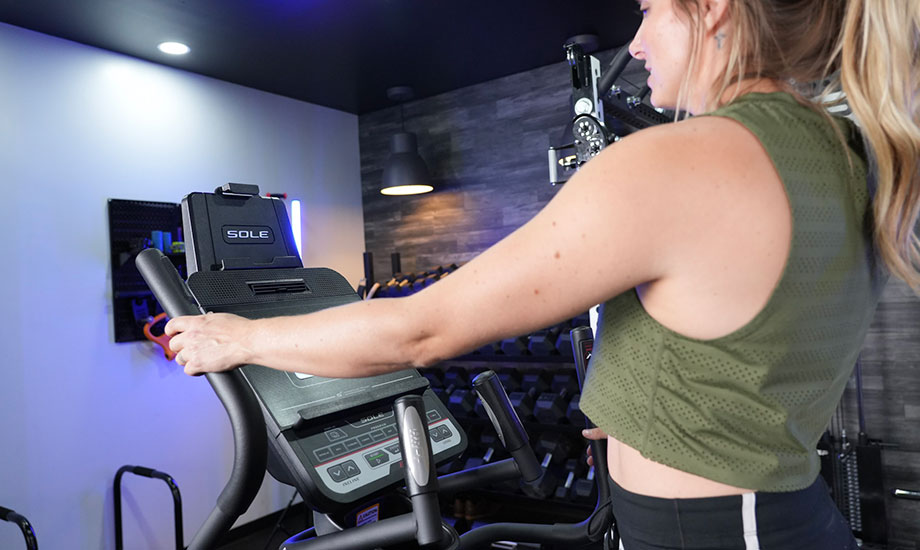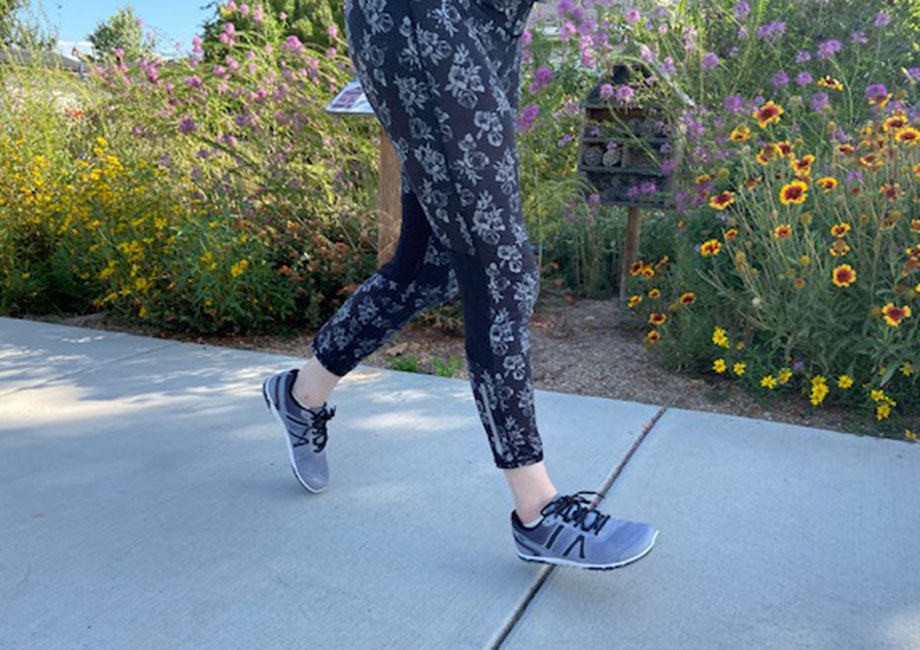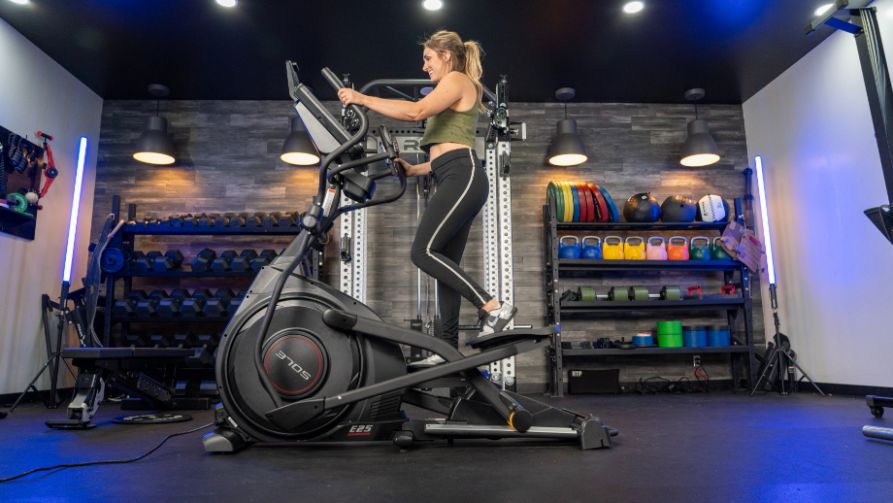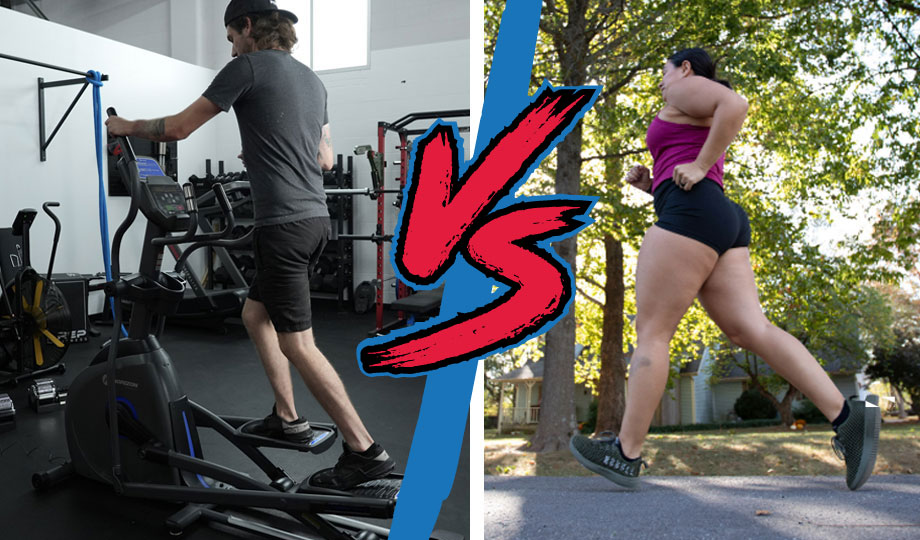We test and review fitness products based on an independent, multi-point methodology. If you use our links to purchase something, we may earn a commission. Read our disclosures.
Alright, let’s talk cardio! Sure, it might not always be the most glamorous part of your workout routine, but let me tell you, the benefits of cardio are totally worth it. When picking your poison for a cardio sesh, where do you begin? You could lace up the best running shoes and hit the road or treadmill. Or maybe you’re eyeing that elliptical machine where you can stand on the pedals and break a sweat without stressing out your knees and ankles too much.
But here’s the big question: which one reigns supreme in the cardiovascular exercise arena? The elliptical is like the low-impact king, hitting multiple muscle groups while being gentle on your joints. It’s perfect for folks looking to boost their heart health and torch some calories without feeling the strain. On the flip side, running’s all about building muscular endurance and stamina, and hey, you can switch things up by running outside or inside, depending on your mood.
As a certified strength and conditioning specialist (CSCS) and personal trainer (CPT), I’ve been knee-deep in the great cardio debate: elliptical vs. running. I’ve helped clients, buddies, and even family figure out which route to take to reach their cardio goals. So get ready, because I’m about to break down the similarities, differences, benefits, and drawbacks of these two cardio champs, helping you figure out which one’s the perfect fit for you!
Elliptical vs. Running: Similarities
Believe it or not, elliptical workouts and running are pretty similar despite the different stride lengths. From the muscles they engage to the aerobic/cardio exercise they offer, they’re like cousins in the fitness world. And the best part? You won’t miss out on much if you switch between them or take a break from your usual routine.
Muscle Engagement
Both elliptical workouts and running engage a similar set of major muscle groups, including the quadriceps, hamstrings, glutes, calves, and core. This balanced muscle activation contributes to overall strength and stability, regardless of the chosen exercise.
Workout Variety
Whether going for a lower-impact workout on the elliptical or hitting the pavement, you have options. Both activities can accommodate various training styles, such as low-intensity steady state (LISS) sessions for endurance, high-intensity interval training (HIIT), and moderate-intensity interval training. This versatility ensures that you can tailor your workouts to align with your fitness goals or preferences.

Impact
Both elliptical workouts and running share the goals of helping improve cardiovascular health, enhancing oxygen consumption, boosting muscular endurance, promoting weight loss, and contributing to improved bone density and lean muscle mass.
Elliptical vs Running: Differences
So, maybe you’re all about that cardio machine life, or you’re the type who lives for the thrill of outdoor runs. Or perhaps you’re part of the crew that loves both! Either way, it’s worth knowing that there are some pretty big differences between hitting the elliptical and pounding the pavement.
The different muscles you work, the kinds of workouts you can do, and how they affect your body can shape your training routine. Let’s take a look at the same points as above but under a different microscope.
Muscle Engagement
Elliptical trainers target your lower-body muscles, including your quadriceps, hamstrings, calves, and glutes, while also engaging the upper body using the handlebars. Your core muscles are only slightly activated.
Running also hits your lower-body muscles but involves greater engagement in your core muscles.
Workout Variety
An elliptical trainer may include preset programs and resistance levels, allowing you to easily adjust your exercise intensity. This creates diverse workout options such as low-intensity steady state, interval training, hill climbs, and cross-training.

Running offers outdoor terrain or indoor variations with the potential for different types of runs, including steady-state, HIIT workouts, tempo, long-distance training, and hill sprints—the main separator for workout types.
Impact
Elliptical trainers provide a lower-intensity workout, making it gentler on your joints and suitable for those experiencing joint pain or recovering from injuries.
Due to its highly repetitive motion and variables with terrain, running is a high-impact, high-intensity workout that places greater stress on your joints. If improper technique and adequate recovery aren’t a part of your routine, there’s a higher risk of injury.
Benefits of the Elliptical
The best ellipticals are like your friendly neighborhood gym buddy. They give you a full-body workout, rev up your metabolism, boost muscle endurance, and keep your heart in top shape all in one exercise machine. Trust me, hopping on an elliptical is worth considering.
Provides a Full-Body Workout
The elliptical targets your lower and upper-body muscle groups, providing engaging sessions that improve muscular endurance and body composition. Its smooth motion engages your quads, hamstrings, glutes, calves, core, and upper-body muscles. By programming elliptical training into your fitness routine, you can expect enhanced muscle definition and a more balanced physique.
Can Be Easier On Your Joints
The fluid motion of the elliptical machine provides a low-impact workout that’s still effective at helping strengthen your heart and lungs while burning calories and increasing stamina. Its ability to improve cardiovascular health, endurance, and weight loss without placing excessive stress on your joints shows it to be a viable substitution for running1.

RELATED: Best Elliptical Workout
Whether you aim to boost your overall fitness level, shed unwanted pounds, or simply improve your cardiovascular health, regular elliptical training can help you achieve your goals safely and sustainably.
Drawbacks of the Elliptical
Elliptical workouts are straightforward. But, like anything else, they also have downsides when you stack them up against other cardio choices.
Less Weight-Bearing Than Running
The low-impact nature of elliptical workouts may not provide the same bone-strengthening benefits as weight-bearing exercises like running. This could potentially impact bone density and lessen the positive effects of lean muscle mass development.
If you’re up for the challenge, don’t hesitate to toss on one of the best weighted vests to counter this.
Can Become Boring Over Time
Keeping your workouts interesting helps adherence. And let’s face it, spending too much time on the elliptical can get dull. The repetitive motion and lack of outdoor scenery might zap your motivation.
May Be Less Functional
While elliptical training boosts cardiovascular fitness and muscle endurance, it may not directly translate to real-life functional movements like running or functional strength training. These latter activities typically involve a broader range of motion and dynamic stability requirements.
Also, doing warm-up exercises before your cardio can enhance muscle activation, stability, and mobility for a better workout!
Benefits of Running
Forget all the flashy running gear and shoes for a minute. There’s a whole bunch of perks that go way beyond fashion.
Can Help Enhance Cardiovascular Performance
Running offers an unparalleled cardiovascular workout for helping improve your heart health, lung capacity, and endurance. In an August 2014 study in the Journal of the American College of Cardiology2, researchers found runners had 30% and 45% lower risks of all-cause and cardiovascular mortality. Regular running can also help enhance your stamina, making daily tasks easier or more efficient.
May Help Aid Weight Loss
Beyond cardiovascular benefits, running is an excellent way to manage weight and promote weight loss. Running burns significant calories, making it an effective tool for creating a calorie deficit, thus shedding excess pounds. Whether you aim to lose weight, maintain a healthy weight, or simply want to improve your body composition, incorporating regular running sessions into your routine may help you achieve those goals while improving overall metabolic health and insulin sensitivity.
RELATED: How Much Cardio To Lose Weight?
May Help Boost Your Mental Health
Running not only enhances physical fitness but also offers significant mental health benefits. A November 2020 study in the International Journal of Environmental Research and Public Health3 states, “Running bouts of variable lengths and intensities, and running interventions can improve mood and mental health…” Running is a great stress reliever, lifting your mood and easing anxiety by releasing those feel-good endorphins. Plus, getting outdoors for a run gives you a refreshing change of scenery, helping you escape the daily grind. Running with friends or joining a run group adds a social element, boosting motivation and camaraderie.
RELATED: Exercise and Mental Health
So, whether you need a mood lift or just a breather from the chaos, hitting the pavement can do wonders for your mental well-being.

Drawbacks of Running
Treat your body right with some mobility and strength workouts to sidestep these downsides. And hey, don’t forget to peek out the window and check the weather forecast before you hit the road!
High Impact On Your Joints
Running is a high-impact activity that can place significant stress on your joints, particularly the knees, hips, and ankles. This repetitive impact can lead to overuse injuries such as shin splints, stress fractures, and tendonitis, especially without proper technique, footwear, and recovery.
RELATED: Shin Splint Stretches
More Potential For Overuse Injuries
Running primarily engages specific muscle groups through repetitive movement patterns, particularly those in your lower body. This repetitive nature can lead to overuse injuries4 and muscular imbalances over time, especially if runners fail to incorporate strength training to address weak areas and improve overall muscular balance and stability.

RELATED: Strength Training For Runners
Can Be Weather Dependent
Running is heavily affected by weather conditions. Inclement weather, extreme temperatures, rain, or snow can make running uncomfortable and challenging, leading to skipped workouts or even injury. If you’re running outdoors, stay hydrated and ease into it with lighter sessions to adjust to the conditions. Having one of the best treadmills for your home gym is a handy backup option.
Elliptical vs. Running: Which Should You Do?
The elliptical trainer is a fantastic option for anyone wanting a low-impact cardio workout that still torches calories, boosts heart health, and works multiple muscle groups. It’s especially great for those with joint issues or recovering from injuries, offering a gentler alternative to high-impact activities like running (watch out for DOMS). Plus, it’s adaptable for different fitness levels, making it beginner-friendly.
As for running, it’s all about that dynamic outdoor experience, letting you explore new terrains and inject adventure into your workout routine. Running can also help build lower-body strength and bone density, thanks to the weight-bearing impact that gives your muscles and bones a good workout. But let’s talk calorie burning: running usually takes the lead here, thanks to its higher impact and greater muscle engagement. It’s also perfect for folks gearing up for races or events, as it hones in on skills like speed, endurance, and mental toughness.
When deciding between the elliptical and running, consider your fitness goals, preferences, and physical limitations. Mixing both can offer a balanced fitness routine, blending low-impact cardio with outdoor running for a well-rounded journey that fits everyone.
Elliptical vs. Running: Final Thoughts
Bottom line: both provide the physical activity you need for overall wellness. Whether setting up an elliptical or lacing your running shoes, you’re in for a heap of benefits, each with its own twist to suit your tastes.
Here’s the lowdown:
- Both elliptical exercise and running can offer numerous benefits for cardiovascular health, weight loss, body composition, endurance, stamina, oxygen consumption, and engaging lower-body muscles.
- The elliptical trainer targets various muscles, including the upper body, providing a low-impact, joint-friendly workout that enhances overall physical performance.
- Running workouts can be more intensive, offering various options such as indoor treadmill workouts, outdoor nature runs, intervals, steady-state runs, and hill sprints.
- Running enhances cardiovascular performance, and the mental health benefits are immeasurable.
- Choosing the best option depends on individual goals, preferences, fitness levels, and pre-existing injuries or limitations. Nevertheless, both the elliptical and running benefit overall health and performance.
Elliptical vs. Running: FAQs
Is an elliptical as good as running?
An elliptical can be just as effective as running for helping improve cardiovascular health and revving up your metabolism. Plus, it works the same leg muscles—glutes, quads, hamstrings, and calves. But here’s the kicker: it’s easier on your joints thanks to its low-impact design and gets your upper body in on the action with those arm movements.
So, if joint problems are a concern, the elliptical has your back. Whether pounding the pavement or gliding on the elliptical, it’s all about finding the right intensity and duration to maintain your dedication and consistency.
Is running or elliptical better for belly fat?
Running and hitting the elliptical can both help, but their impact depends on other factors—like what you eat, how hard you go at it, your body composition, and how fit you are. Your best bet for losing weight is to mix things up: throw in some cardio (running or elliptical), pump some iron with strength training, and stick to a healthy diet.
Oh, and don’t forget consistency—keep at it, and make sure you’re burning more calories than you’re taking in. That’s the ticket to reaching your fat-loss goals.
How many times a week should I do elliptical?
Your ideal frequency of elliptical workouts depends on your preferences and fitness level. If you’re just getting started, aim for two to three sessions a week, lasting 15 to 30 minutes each. For seasoned gym buffs, bump it to three to five sessions for 30 to 60 minutes each time.
Mix it up between steady-state and interval workouts to keep things fresh and challenge your body. And don’t forget to balance it with strength training and mobility exercises for overall fitness and wellness.
References
- Bosch, Andrew N et al. “Physiological and Metabolic Responses to Exercise on Treadmill, Elliptical Trainer, and Stepper: Practical Implications for Training.” International journal of sport nutrition and exercise metabolism vol. 31,2 (2021): 135-142. doi:10.1123/ijsnem.2020-0155
- Lee, Duck-Chul et al. “Leisure-time running reduces all-cause and cardiovascular mortality risk.” Journal of the American College of Cardiology vol. 64,5 (2014): 472-81. doi:10.1016/j.jacc.2014.04.058
- Oswald, Freya et al. “A Scoping Review of the Relationship between Running and Mental Health.” International journal of environmental research and public health vol. 17,21 8059. 1 Nov. 2020, doi:10.3390/ijerph17218059
- Ferber, Reed et al. “Suspected mechanisms in the cause of overuse running injuries: a clinical review.” Sports health vol. 1,3 (2009): 242-6. doi:10.1177/1941738109334272
Further reading

Looking for a new home training plan? Read our Invictus Strength Program Review to find out what our tester thought of this strength training program. Read more

The XPO Trainer Sled is quite possibly the best weight sled for most home gym owners. Thanks to its magnetic resistance, it makes much less noise than a traditional sled, which, therefore makes much fewer complaints from neighbors. The XPO Trainer Sled 2.0 builds upon the previous version with minor improvements that make it an even easier recommendation. Read more

Looking for general support or preparing for a heavy deadlift? Our fitness experts have tested the best weightlifting belts for your fitness needs. Read more

Considering a vegan diet? There are many plant-based protein powder benefits, such as ease of digestion, lowered environmental impact, and more! Read more

